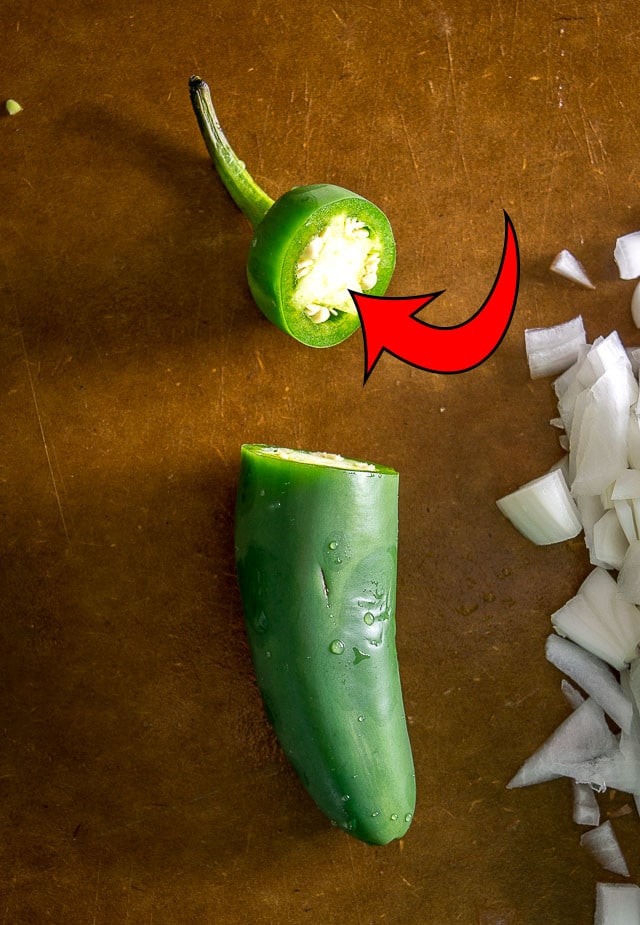Spend three minutes reading this post and you will officially be an expert on serranos and jalapenos!
I know it's a point of confusion for peeps because one of the most common questions I get is...
Can I substitute serrano for jalapeno?
The quick answer is "Yes, go for it!" as they aren't as different as people think they are!
Their flavor is quite similar, so I tend to use them interchangeably. But you'll definitely want to get familiar with the differences in their heat levels.
Which is hotter: Serrano or Jalapeno?
Here's what you need to know about their fire:
In the above pic take note of the Scoville rating of the serrano -- it's about 3-4 times higher than the jalapeno! In other words, a serrano's capsaicin concentration is 3-4 times higher than the jalapeno. What is capsaicin?
And note that the exact heat level of a chile will depend on growing conditions and that's why you'll see a range for each pepper.
That photo also reveals a good tip to keep in mind when comparing different chile varieties -- they tend tend to get hotter as they get smaller. And the serrano is typically smaller and thinner than jalapenos, and hotter!
And their taste?
As mentioned, I tend to use them interchangeably as their flavor is quite similar. Serranos do taste a bit more grassy to most people, and of course a bit sharper because of the higher heat level.
So when you see a recipe call for a jalapeno and all you've got is serrano, then no problem! Just know that you may need to use less serrano because it's got some fire!
A quick way to gauge the heat of these peppers is to stick the tip of your tongue right here:
Please don't do this if you are sensitive to spicy foods! And don't do it with habaneros! More tips on handling hot chile peppers.
But with jalapenos and serranos I usually give them the quick tongue test to get a preview of their heat level. You might be surprised how much variation there is between identical looking chiles.
And yes, the highest concentrations of capsaicin (heat) will tend to lie in the pith and seeds of the chiles (see above pic). That's why you'll frequently see recipes recommending to scrape out the seeds for a milder version. I never do this though -- instead of scraping out the seeds I will typically just use less of the chile if I want to temper the heat.
Which brings up one final tip to keep in mind when cooking with jalapenos and serranos...
It's much easier to add heat to a dish then it is to take it away, so I typically recommend adding the jalapeno (or serrano) incrementally the first time you make a dish.
For example, when making this Tomato Jalapeno Salsa you can slice the jalapeno in quarters and add a sliver at a time until it tastes right to you. People have such a wide range of tolerance for heat and recipes rarely take this into account.
Once you get familiar with a dish you can fast forward through this step, but when working with a new recipe it's worth adding the heat incrementally and doing some taste testing along the way.
Okay, I hope this post solves jalapenos and serranos for you!
At the very least please keep in mind that you can always substitute a serrano for a jalapeno, and vice versa, as long as you keep the heat differences in mind. So no more skipping recipes if you don't have the exact pepper on hand!
Feel free to get in touch if you have any other questions about these chiles. I'll list some favorite recipes down below if you're fired up and ready to start cooking. Cheers.
Roasted Tomato and Tomatillo Salsa
Serrano vs. Habanero: Which is Hotter?
Poblano vs. Jalapeno: Which is Hotter?
Want the latest recipe? Click your favorite from these options and follow me: Instagram, Facebook, Pinterest, TikTok, YouTube.
Still hungry?!
Want to receive Mexican Please recipes via email when they are posted? Sign up below to subscribe. All recipes are spam free.








